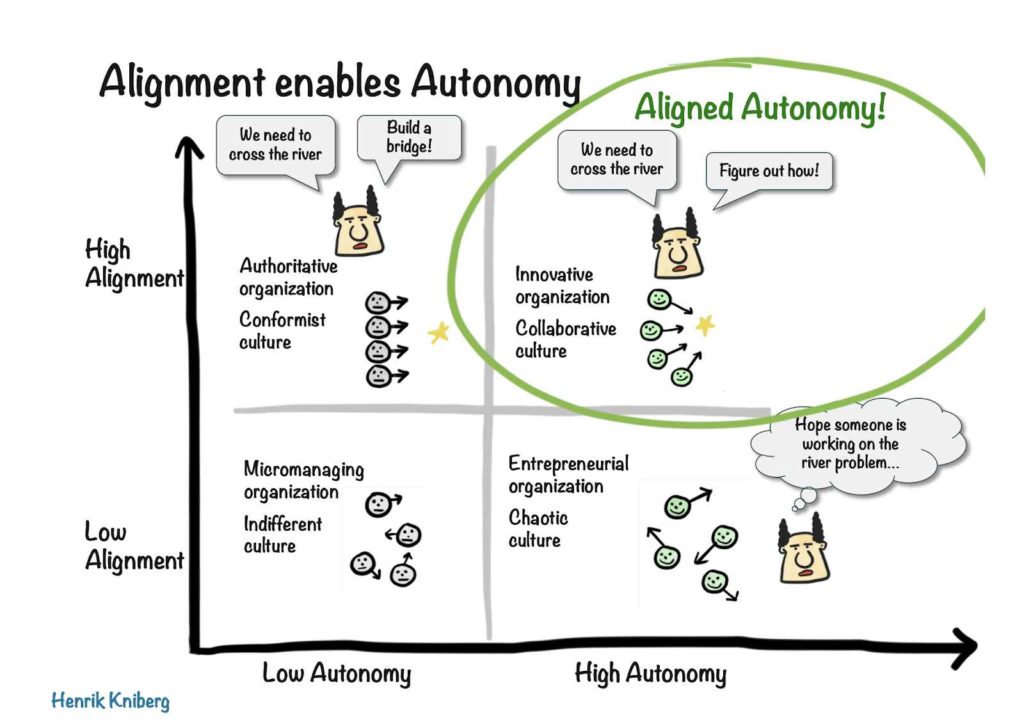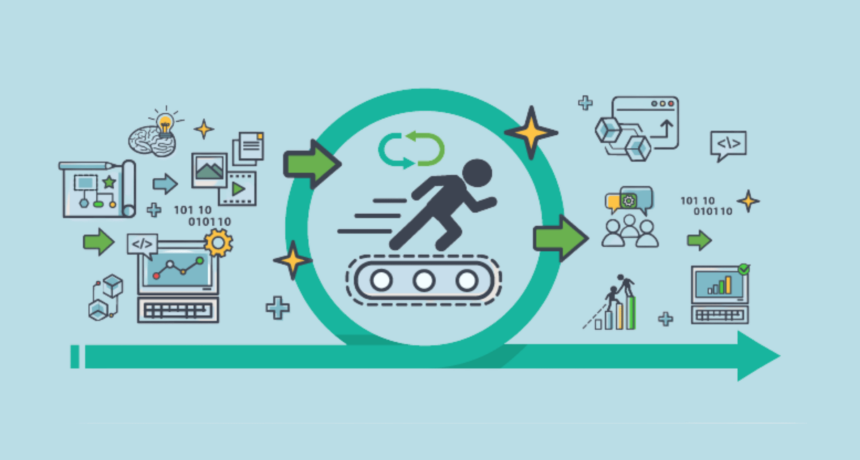Technology and globalization 2.0 have created rapid changes in every industry, demanding organizations to respond to increased competition and market changes at a much faster pace. Take the financial services industry for example. In the last 20 years, numerous fintech disruptors have touched all aspects of the financial services industry, taking away market share and customers from banks and traditional institutions. Are traditional banks not agile enough? They have been practicing agile for over a decade. Will practicing scaled agile solve this problem?
If you Google “agile at scale”, or “how to scale agile”, your search results will likely be full of the ingeniously marketed framework, “Agile at Scale for Enterprise”, aka “SAFe”. Is this the answer you’re looking for in order to achieve product-led growth or product agility?
What is Scaled Agile Framework (SAFe)?
The name of SAFe implies agility for larger organizations. However looking further into the details, it turns out to be something very different.
The Scaled Agile Framework has good intentions but it doesn’t have a great reputation amongst product leaders.
“There’s this process out that I’m really hoping nobody in this room uses. It is called SAFe (Scaled Agile Framework), which is used by big IT organizations like banks and insurance companies a lot. Let me just say it has nothing to do with Agile. It’s just marketing but has nothing to do with Agile. I don’t know a single tech product company that uses it”
– Marty Cagan, (Author of Empowered) in his Product Thinking Mixer Keynote, 2019
“Layers of process… layers of management… too much focus on methodology…lack of autonomy… lack of agility… hiding real issues”
– Product coalition – “Be Agile, not SAFe”
“I’ve trained dozens of teams who are using SAFe, and I have never seen it work well. Although the appearance of having a framework that lays out everything you need to do technology-wise in nice neat boxes sounds appealing, in practice it usually breaks down.”
– Melissa Perri, in her book “Escaping the Build Trap”
So if the Scaled Agile Framework is not the magic answer that prevents disruptors from outrunning existing businesses, what options do companies have?
Before providing a solution, let’s take a look at why disruptors become successful. How do they rapidly expand and steal market share with much less capital, brand power, and a smaller customer base? What is the secret to success?
Product-Led vs. Project-Led Development
One striking difference between disruptors and incumbents is their development approach. The disruptors are product-led companies. Whereas the incumbents often adopt a project-based product development approach.
A project-based organization separates both strategy and execution as two distinct phases between executives and teams. Executives set goals, approve a list of initiatives and their budget, and send them to teams for execution. To measure team success, look at the output with metrics like sprint velocity or features released. Additionally, team sizes are fixed and everyone has a partial scope of a product to iterate on. When teams turn agile, they each face their own “product vision” and backlog, while in reality, they rely on other teams to deliver. Hence the infamous “agile madness” occurs.

A product-led organization focuses on outcomes – both customer outcomes and business outcomes. It aligns and empowers teams, adopts a discover-first and deliver-next continuously iterative process, and it also adjusts focus and resource allocation based on the previous outcome.
Product-led organizations adopt Responsive Product Portfolio Management – a flexible framework incorporating agile and product thinking principles. Additionally, they apply it to all levels of the organization by iteratively connecting goals, customers, and product strategy with agile delivery.
Achieve True Agility at Scale with Responsive Product Portfolio Management
Most companies know by now that the traditional top-down, command-and-control approach in the project portfolio management framework does not work well for winning customers or staying ahead of the competition.
However, letting all agile teams run autonomously also creates challenges, including misalignment, chaos, and often incongruent customer experiences.
It is only possible to achieve true agility collectively, by delivering value to customers, across all the functions and teams involved.
So what are the solutions?

The responsive product portfolio management approach connects executives with teams via alignment on goals and strategies. It empowers teams with the resources and autonomy to discover, iterate, and deliver products that solve customer problems and realize business outcomes.
Today’s world demands responsive organizations. Responsive Product Portfolio Management (“Responsive PPM”) empowers true agility at scale by dynamically connecting objectives, customers’ needs, products, and resources with execution, to accelerate outcomes responsive to the state of the organization and the market.
Facilitate Scaled Agile Principles with a Responsive PPM Tool like Dragonboat
Responsive PPM empowers true agility at scale for product-led organizations.
What are the benefits of a responsive product portfolio framework?
- Connect goals, strategies and initiatives to enable a strategic framework and context for empowered teams
- Increase transparency and collaboration up, down, and across levels
- Have a source of truth portfolio hub where everyone can easily find out the why, what, who, when, and how of the product portfolio for context (better decisions) and speed (faster decisions)
- Responsive, customizable prioritization: with the context of goals and customers and adjusts product and focus-based on outcomes
- Support flexible team workflows – an agile team practice should continue unless data indicates the needs for change
A product-led organization needs to pull all these pieces together. A responsive PPM tool like Dragonboat is the essential hub and enabler for an effective product organization and its stakeholders.
A tool enables executives and teams to achieve alignment on multiple portfolio dimensions, such as objectives, themes, and categories. Teams can then brainstorm and discover product ideas that best align with these dimensions.
A tool provides visibility on real-time allocation by any dimension, allowing assessment in whether product teams could be unknowingly over or under-invested in certain areas. For example, a product that’s been in the market with a high level of adoption often over-invests in revenue-generating features and under-invests in product expansion-related discovery. It may not be an intentional sin, but the data is invisible during product portfolio planning until a real-time allocation view becomes available.

A Responsive PPM tool like Dragonboat enables the interaction and connection between 3 operating horizons – bets, initiatives, and features. Each of the horizons maps to the long term, mid term, and near term focus. They each map to their respective goals and evaluate their own contribution to these goals.
Seamlessly connect with agile tools like Jira, Azure Dev Ops, Clubhouse, Github issues for a 2-way-sync between strategy and execution, without interrupting current team workflows.
Enable visibility at all levels with automated alignment from executives to teams for context, and roll up progress from teams to stakeholders.
When SAFe Works For Product-Led Organizations
Scaled Agile Framework alone is not enough for outcome driven product teams. Facilitate Scaled Agile Principles with outcome driven responsive PPM to connect the dots.
Should you wait until the process and culture change before you adopt a tool? No, you should let the tool and process happen together iteratively and in an agile rollout fashion. A properly implemented tool facilitates and reinforces the right behavior.
Transformation requires tools built for the new way of working. Traditional tools are built upon traditional methodologies that the transformation is meant to change. Dragonboat is built to enable the most innovative companies in Silicon Valley to adopt product portfolio best practices.
– CIO, ACB, Dragonboat customer case study
Dragonboat’s responsive PPM platform can be seamlessly integrated with the SAFe framework so that companies can finally align strategies and execution to achieve true agility at scale by continuously creating products that customers love while achieving business outcomes.




